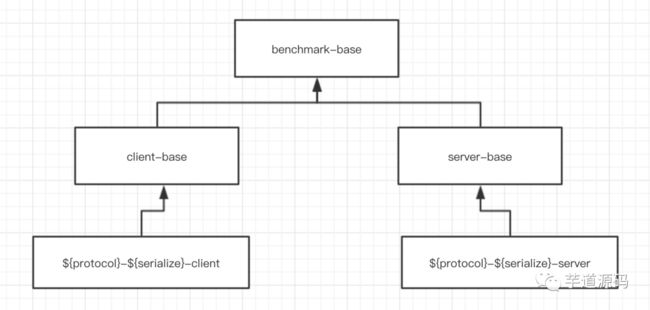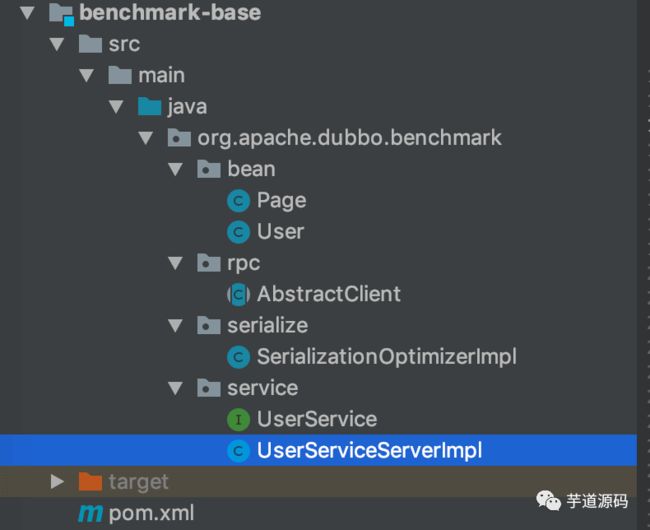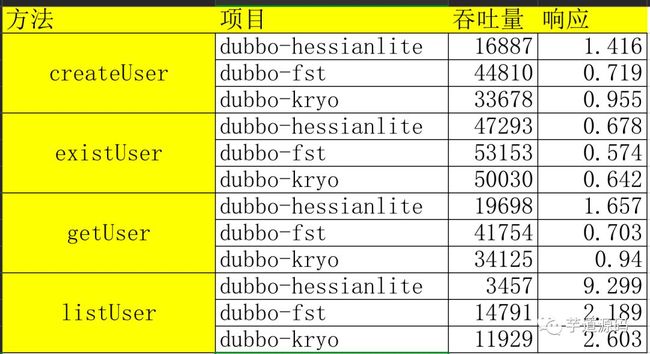性能测试 —— Dubbo 基准测试
点击上方“芋道源码”,选择“设为星标”
做积极的人,而不是积极废人!
源码精品专栏
中文详细注释的开源项目
RPC 框架 Dubbo 源码解析
网络应用框架 Netty 源码解析
消息中间件 RocketMQ 源码解析
数据库中间件 Sharding-JDBC 和 MyCAT 源码解析
作业调度中间件 Elastic-Job 源码解析
分布式事务中间件 TCC-Transaction 源码解析
Eureka 和 Hystrix 源码解析
Java 并发源码
摘要: 原创出处 http://www.iocoder.cn/Performance-Testing/Dubbo-benchmark/ 「芋道源码」欢迎转载,保留摘要,谢谢!
1. 概述
2. 性能指标
3. 测试工具
4. dubbo-benchmark
666. 彩蛋
1. 概述
在 2019.05.21 号,在经历了 1 年多的孵化,Dubbo 终于迎来了 Apache 毕业。在这期间,Dubbo 做了比较多的功能迭代,提供了 NodeJS、Python、Go 等语言的支持,也举办了多次社区活动,在网上的“骂声”也少了。
作为一个长期使用,并且坚持使用 Dubbo 的开发者,还是比较愉快的。可能,又经历了一次技术正确的选择。当然,更愉快的是,Spring Cloud Alibaba 貌似,也孵化的差不多,双剑合并,biubiubiu 。
本文,我们就来对 Dubbo 做一次性能基准测试。当写下这句话,突然想到了徐大sao:“今天天气不错,所以来吃顿好的”。
2. 性能指标
在 Dubbo 官方团队提供的 《Dubbo 性能测试报告》 的文章里,我们比较明确的可以看到希望的性能指标:
场景名称 对应指标名称 期望值范围 实际值 是否满足期望(是/否) 1k数据 响应时间 0.9ms 0.79ms 是 1k数据 TPS 10000 11994 是
3. 测试工具
目前可用于 Dubbo 测试的工具如下:
dubbo-benchmark :Dubbo 官方,基于 JMH 实现的 Dubbo 性能基准测试工具。
对 JMH 不了解的胖友,可以看看 forever alone 的基友写的 《JAVA 拾遗 — JMH 与 8 个测试陷阱》
jmeter-plugins-for-apache-dubbo :社区贡献,压力测试工具 Jmeter 对 Dubbo 的插件拓展。
考虑到测试的简便性,以及学习成本(大多数人不会使用 JMeter),所以我们采用 dubbo-benchmark ,虽然说 JMH 也好多人不会。但是,因为 dubbo-benchmark 提供了开箱即用的脚本,即使不了解 JMH ,也能很方便的快速上手。当然,还是希望胖友能去了解下 JMH ,毕竟是 Java 微基准测试框架,可以用来测试我们编写的很多代码的性能。
4. dubbo-benchmark
4.1 项目结构
在开始正式测试之前,我们先来了解下 dubbo-benchmark 项目的大体结构。
 项目结构
项目结构
分了比较多的 Maven 模块,我们将它们的关系,重新梳理如下图:
 项目层级
项目层级
第一层 benchmark-base
提供 Dubbo Service 的实现,如下图:
 benchmark-base
benchmark-base
UserService 类中,定义了我们业务场景中常用的四种方法:
UserServiceImpl 的实现,胖友自己看下,比较简单。
AbstractClient,理论来说,应该放到 client-base 中,可能迷路了。
第二层 client-base
实现 Dubbo 消费端的,基于 JMH ,实现 Benchmark 基类。重点在 benchmark.Client 类,代码如下:
private static final int CONCURRENCY = 32;public static void main(String[] args) throws Exception { Options opt; ChainedOptionsBuilder optBuilder = new OptionsBuilder() // benchmark 所在的类名,此处就是 Client .include(Client.class.getSimpleName()) // 预热 3 轮,每轮 10 秒 .warmupIterations(3) .warmupTime(TimeValue.seconds(10)) // 测量(测试)3 轮,每轮 10 秒 .measurementIterations(3) .measurementTime(TimeValue.seconds(10)) // 并发线程数为 32 .threads(CONCURRENCY) // 进行 fork 的次数。如果 fork 数是 2 的话,则 JMH 会 fork 出两个进程来进行测试。 .forks(1); // 设置报告结果 opt = doOptions(optBuilder).build(); new Runner(opt).run();}private static ChainedOptionsBuilder doOptions(ChainedOptionsBuilder optBuilder) { String output = System.getProperty("benchmark.output"); if (output != null && !output.trim().isEmpty()) { optBuilder.output(output); } return optBuilder;}胖友自己看下注释。
如果对 JMH 还是不了解的胖友,可以再看看如下两篇文章:
《Java 微基准测试框架 JMH》
《Java 并发编程笔记:JMH 性能测试框架》
在 Client 类中,定义了对 UserService 调用的四个 Benchmark 方法,代码如下:
private final ClassPathXmlApplicationContext context;private final UserService userService;public Client() { // 读取 consumer.xml 配置文件,并启动 Spring 容器。这个配置文件,由子项目配置 context = new ClassPathXmlApplicationContext("consumer.xml"); context.start(); // 获得 UserService Bean userService = (UserService) context.getBean("userService");}@Overrideprotected UserService getUserService() { return userService;}@TearDownpublic void close() throws IOException { ProtocolConfig.destroyAll(); context.close();}@Benchmark@BenchmarkMode({Mode.Throughput, Mode.AverageTime, Mode.SampleTime})@OutputTimeUnit(TimeUnit.MILLISECONDS)@Overridepublic boolean existUser() throws Exception { return super.existUser();}@Benchmark@BenchmarkMode({Mode.Throughput, Mode.AverageTime, Mode.SampleTime})@OutputTimeUnit(TimeUnit.MILLISECONDS)@Overridepublic boolean createUser() throws Exception { return super.createUser();}@Benchmark@BenchmarkMode({Mode.Throughput, Mode.AverageTime, Mode.SampleTime})@OutputTimeUnit(TimeUnit.MILLISECONDS)@Overridepublic User getUser() throws Exception { return super.getUser();}@Benchmark@BenchmarkMode({Mode.Throughput, Mode.AverageTime, Mode.SampleTime})@OutputTimeUnit(TimeUnit.MILLISECONDS)@Overridepublic Page listUser() throws Exception { return super.listUser();} 第二层 server-base
实现 Dubbo 消费端的,启动 Dubbo 服务。重点在 benchmark.Server 类,代码如下:
public class Server { public static void main(String[] args) throws InterruptedException { // 读取 provider.xml 配置文件,并启动 Spring 容器。这个配置文件,由子项目配置 try (ClassPathXmlApplicationContext context = new ClassPathXmlApplicationContext("provider.xml")) { context.start(); // sleep ,防止进程结束 Thread.sleep(Integer.MAX_VALUE); } }}因为是被测方,所以无需集成到 JMH 中。
第三层 {protocol}-{serialize}-client
具体协议( Protocol ),使用具体序列化( Serialize ) 方式的消费者。
第四层 {protocol}-{serialize}-server
具体协议( Protocol ),使用具体序列化( Serialize ) 方式的提供者。
4.2 测试环境
型号 :ecs.c5.xlarge
艿艿:和我一样抠门(穷)的胖友,可以买竞价类型服务器,使用完后,做成镜像。等下次需要使用的时候,恢复一下。HOHO 。
系统 :CentOS 7.6 64位
CPU :4 核
内存 :8 GB
磁盘 :40 GB ESSD 云盘
Java :OpenJDK Runtime Environment (build 1.8.0_212-b04)
Dubbo :2.6.1
> 虽然 Dubbo 项目本身已经完成孵化,但是 dubbo-benchmark 并未更新到最新版本的 2.7.2 。所以,本文还是测试 Dubbo 2.6.1 版本。当然,这个对测试结果影响不大,妥妥的。
4.3 安装 dubbo-benchmark
第一步,克隆项目
git clone https://github.com/apache/dubbo-benchmark.gitcd dubbo-benchmark第二步,启动服务提供者
sh benchmark.sh dubbo-kryo-server会有一个编译的过程,耐心等待。
第三步,启动服务消费者
需要新启一个终端
sh benchmark.sh dubbo-kryo-client开始 JMH 测试…整个测试过程,持续 15 分钟左右。
4.4 dubbo-hessianlite
本小节,我们来测试 dubbo-hessianlite-client 和 dubbo-hessianlite-server 。
这个组合,是我们使用 Dubbo 最主流的方式。
协议:Dubbo
序列化:hessian-lite ,Dubbo 对 Hessian 提供的序列化方式的性能优化和 Bug 修复。
通信:Netty4
第一步,启动服务提供者
sh benchmark.sh dubbo-hessianlite-server第二步,启动服务消费者
需要新启一个终端
sh benchmark.sh dubbo-hessianlite-client? 测试结果
Benchmark Mode Cnt Score Error UnitsClient.createUser thrpt 3 16.887 ? 1.729 ops/msClient.existUser thrpt 3 47.293 ? 4.993 ops/msClient.getUser thrpt 3 19.698 ? 8.588 ops/msClient.listUser thrpt 3 3.457 ? 0.180 ops/msClient.createUser avgt 3 1.416 ? 0.308 ms/opClient.existUser avgt 3 0.678 ? 0.038 ms/opClient.getUser avgt 3 1.657 ? 0.359 ms/opClient.listUser avgt 3 9.299 ? 0.872 ms/opClient.createUser sample 499898 1.918 ? 0.007 ms/opClient.createUser:createUser?p0.00 sample 0.279 ms/opClient.createUser:createUser?p0.50 sample 1.448 ms/opClient.createUser:createUser?p0.90 sample 2.613 ms/opClient.createUser:createUser?p0.95 sample 3.027 ms/opClient.createUser:createUser?p0.99 sample 9.732 ms/opClient.createUser:createUser?p0.999 sample 16.876 ms/opClient.createUser:createUser?p0.9999 sample 28.280 ms/opClient.createUser:createUser?p1.00 sample 39.453 ms/opClient.existUser sample 1376160 0.697 ? 0.002 ms/opClient.existUser:existUser?p0.00 sample 0.094 ms/opClient.existUser:existUser?p0.50 sample 0.647 ms/opClient.existUser:existUser?p0.90 sample 0.842 ms/opClient.existUser:existUser?p0.95 sample 0.921 ms/opClient.existUser:existUser?p0.99 sample 1.425 ms/opClient.existUser:existUser?p0.999 sample 10.355 ms/opClient.existUser:existUser?p0.9999 sample 16.145 ms/opClient.existUser:existUser?p1.00 sample 24.773 ms/opClient.getUser sample 568869 1.686 ? 0.006 ms/opClient.getUser:getUser?p0.00 sample 0.262 ms/opClient.getUser:getUser?p0.50 sample 1.436 ms/opClient.getUser:getUser?p0.90 sample 1.954 ms/opClient.getUser:getUser?p0.95 sample 2.609 ms/opClient.getUser:getUser?p0.99 sample 9.634 ms/opClient.getUser:getUser?p0.999 sample 15.862 ms/opClient.getUser:getUser?p0.9999 sample 31.217 ms/opClient.getUser:getUser?p1.00 sample 44.302 ms/opClient.listUser sample 103394 9.272 ? 0.038 ms/opClient.listUser:listUser?p0.00 sample 1.792 ms/opClient.listUser:listUser?p0.50 sample 9.060 ms/opClient.listUser:listUser?p0.90 sample 14.287 ms/opClient.listUser:listUser?p0.95 sample 15.679 ms/opClient.listUser:listUser?p0.99 sample 17.336 ms/opClient.listUser:listUser?p0.999 sample 30.966 ms/opClient.listUser:listUser?p0.9999 sample 38.161 ms/opClient.listUser:listUser?p1.00 sample 45.351 ms/op4.5 dubbo-fst
本小节,我们来测试 dubbo-fst-client 和 dubbo-fst-server 。
这个组合,是我们使用 Dubbo 最主流的方式。
协议:Dubbo
序列化:FST
通信:Netty4
第一步,启动服务提供者
sh benchmark.sh dubbo-fst-server第二步,启动服务消费者
需要新启一个终端
sh benchmark.sh dubbo-fst-client? 测试结果
Benchmark Mode Cnt Score Error UnitsClient.createUser thrpt 3 44.810 ? 5.152 ops/msClient.existUser thrpt 3 53.153 ? 49.787 ops/msClient.getUser thrpt 3 41.754 ? 8.210 ops/msClient.listUser thrpt 3 14.791 ? 3.458 ops/msClient.createUser avgt 3 0.719 ? 0.080 ms/opClient.existUser avgt 3 0.574 ? 0.434 ms/opClient.getUser avgt 3 0.703 ? 0.045 ms/opClient.listUser avgt 3 2.189 ? 0.353 ms/opClient.createUser sample 1267915 0.756 ? 0.002 ms/opClient.createUser:createUser?p0.00 sample 0.099 ms/opClient.createUser:createUser?p0.50 sample 0.678 ms/opClient.createUser:createUser?p0.90 sample 0.888 ms/opClient.createUser:createUser?p0.95 sample 1.034 ms/opClient.createUser:createUser?p0.99 sample 3.383 ms/opClient.createUser:createUser?p0.999 sample 10.502 ms/opClient.createUser:createUser?p0.9999 sample 22.650 ms/opClient.createUser:createUser?p1.00 sample 35.979 ms/opClient.existUser sample 1461428 0.656 ? 0.002 ms/opClient.existUser:existUser?p0.00 sample 0.077 ms/opClient.existUser:existUser?p0.50 sample 0.504 ms/opClient.existUser:existUser?p0.90 sample 1.128 ms/opClient.existUser:existUser?p0.95 sample 1.516 ms/opClient.existUser:existUser?p0.99 sample 2.802 ms/opClient.existUser:existUser?p0.999 sample 6.452 ms/opClient.existUser:existUser?p0.9999 sample 33.358 ms/opClient.existUser:existUser?p1.00 sample 58.262 ms/opClient.getUser sample 1270938 0.755 ? 0.003 ms/opClient.getUser:getUser?p0.00 sample 0.084 ms/opClient.getUser:getUser?p0.50 sample 0.588 ms/opClient.getUser:getUser?p0.90 sample 1.034 ms/opClient.getUser:getUser?p0.95 sample 1.626 ms/opClient.getUser:getUser?p0.99 sample 4.473 ms/opClient.getUser:getUser?p0.999 sample 10.830 ms/opClient.getUser:getUser?p0.9999 sample 27.719 ms/opClient.getUser:getUser?p1.00 sample 45.875 ms/opClient.listUser sample 442763 2.166 ? 0.009 ms/opClient.listUser:listUser?p0.00 sample 0.306 ms/opClient.listUser:listUser?p0.50 sample 1.767 ms/opClient.listUser:listUser?p0.90 sample 3.039 ms/opClient.listUser:listUser?p0.95 sample 4.415 ms/opClient.listUser:listUser?p0.99 sample 11.551 ms/opClient.listUser:listUser?p0.999 sample 21.045 ms/opClient.listUser:listUser?p0.9999 sample 32.702 ms/opClient.listUser:listUser?p1.00 sample 45.089 ms/op4.6 dubbo-kryo
本小节,我们来测试 dubbo-kryo-client 和 dubbo-kryo-server 。
协议:Dubbo
序列化:Kryo
通信:Netty4
第一步,启动服务提供者
sh benchmark.sh dubbo-kryo-server第二步,启动服务消费者
需要新启一个终端
sh benchmark.sh dubbo-kryo-client? 测试结果
Benchmark Mode Cnt Score Error UnitsClient.createUser thrpt 3 33.678 ? 2.656 ops/msClient.existUser thrpt 3 50.030 ? 3.509 ops/msClient.getUser thrpt 3 34.125 ? 4.886 ops/msClient.listUser thrpt 3 11.929 ? 1.746 ops/msClient.createUser avgt 3 0.955 ? 0.164 ms/opClient.existUser avgt 3 0.642 ? 0.051 ms/opClient.getUser avgt 3 0.940 ? 0.071 ms/opClient.listUser avgt 3 2.603 ? 0.748 ms/opClient.createUser sample 985106 0.973 ? 0.003 ms/opClient.createUser:createUser?p0.00 sample 0.148 ms/opClient.createUser:createUser?p0.50 sample 0.855 ms/opClient.createUser:createUser?p0.90 sample 1.147 ms/opClient.createUser:createUser?p0.95 sample 1.315 ms/opClient.createUser:createUser?p0.99 sample 5.300 ms/opClient.createUser:createUser?p0.999 sample 12.517 ms/opClient.createUser:createUser?p0.9999 sample 21.037 ms/opClient.createUser:createUser?p1.00 sample 31.850 ms/opClient.existUser sample 1470527 0.652 ? 0.001 ms/opClient.existUser:existUser?p0.00 sample 0.092 ms/opClient.existUser:existUser?p0.50 sample 0.601 ms/opClient.existUser:existUser?p0.90 sample 0.800 ms/opClient.existUser:existUser?p0.95 sample 0.876 ms/opClient.existUser:existUser?p0.99 sample 1.550 ms/opClient.existUser:existUser?p0.999 sample 9.650 ms/opClient.existUser:existUser?p0.9999 sample 14.844 ms/opClient.existUser:existUser?p1.00 sample 30.573 ms/opClient.getUser sample 1001893 0.957 ? 0.004 ms/opClient.getUser:getUser?p0.00 sample 0.127 ms/opClient.getUser:getUser?p0.50 sample 0.741 ms/opClient.getUser:getUser?p0.90 sample 1.401 ms/opClient.getUser:getUser?p0.95 sample 2.191 ms/opClient.getUser:getUser?p0.99 sample 5.546 ms/opClient.getUser:getUser?p0.999 sample 12.059 ms/opClient.getUser:getUser?p0.9999 sample 24.518 ms/opClient.getUser:getUser?p1.00 sample 49.873 ms/opClient.listUser sample 363958 2.636 ? 0.013 ms/opClient.listUser:listUser?p0.00 sample 0.390 ms/opClient.listUser:listUser?p0.50 sample 2.071 ms/opClient.listUser:listUser?p0.90 sample 4.084 ms/opClient.listUser:listUser?p0.95 sample 6.947 ms/opClient.listUser:listUser?p0.99 sample 12.403 ms/opClient.listUser:listUser?p0.999 sample 22.940 ms/opClient.listUser:listUser?p0.9999 sample 40.935 ms/opClient.listUser:listUser?p1.00 sample 60.097 ms/op4.7 小结
可能有胖友,对 JMH 的结果报告不熟悉,这里简单介绍下:
Mode :thrpt ,throughput 的缩写,吞吐量,单位为:ops/ms ,所以需要乘以 1000 ,换算成 QPS 。
Mode :avgt ,AverageTime 的缩写,每个操作?的时间,单位为 ms 毫秒。
Mode :sample ,采样分布。每一行代表,代表百分之多少(
?p)的请求,在多少毫秒内。
整理结果如下表:
 性能结果
性能结果
三个测试用例,差别是序列化使用的库,所以序列化的性能,决定了整体的性能结果。
方法的性能排行是:existUser > getUser > createUser > listUser
项目的性能排行是:dubbo-fst > dubbo-kryo > dubbo-hessianlite
当然,得到这样一个测试结果,我们很自然的会有一个疑惑,既然 FST 和 Kryo 性能比 Hessian Lite 好,为什么默认选择的还是 Hessian Lite 呢?因为在 RPC 场景下,我们有跨语言的诉求,而 FST 和 Kryo 是 Java 序列化的库,不支持跨语言,而 Hessian Lite 支持。
666. 彩蛋
因为 dubbo-benchmark 项目的存在,所以整个测试的过程,体验还是比较舒服,测试也是非常顺利的。当然,还是比较期待 dubbo-benchmark 后续能更新的更牛逼:
例如说,支持更多的序列化方式,因为最新版本有了 Gson、Probufstuff 等新的序列化支持
再例如说,支持除了 Dubbo 协议之外,Rest 等等。
也推荐下如下文章:
《Dubbo 容量规划》
《性能测试工具 Jmeter 测试 Dubbo 接口脚本编写》
《在Dubbo中使用高效的 Java 序列化(Kryo 和 FST)》
《基于 Dubbo 框架下的 RPC 通讯协议性能测试》
《孰优孰劣?Dubbo VS Spring Cloud 性能测试大对决!》
欢迎加入我的知识星球,一起探讨架构,交流源码。加入方式,长按下方二维码噢:
![]()
已在知识星球更新源码解析如下:
![]()
![]()
![]()
如果你喜欢这篇文章,喜欢,转发。
生活很美好,明天见(。・ω・。)ノ♡